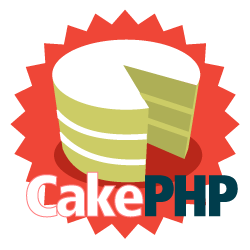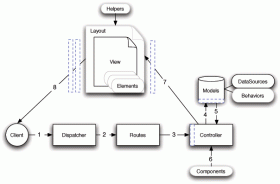 So you’ve got a sweet idea for a web application—great, let’s get to work! You’ll need a basic GUI, some sort of user registration, a templating system, logic processing, error handlers, form verification, AJAX processing, and… woah, this is adding up in a hurry. At what point do you get to start making the app itself?
So you’ve got a sweet idea for a web application—great, let’s get to work! You’ll need a basic GUI, some sort of user registration, a templating system, logic processing, error handlers, form verification, AJAX processing, and… woah, this is adding up in a hurry. At what point do you get to start making the app itself?
What you need is a framework that will accelerate your app development by offering an easy way to employ common components to a site and the flexibility to quickly add custom logic. This is where CakePHP enters the stage.
CakePHP is a PHP framework that simplifies the way you do programming. What do I mean by “framework”? This concept is best explained by making a comparison with traditional application scripts: a typical PHP script starts at the top and proceeds to the bottom while utilizing included classes to create objects and processes the intended logic. An error in your syntax ruins everything, and you need to manually code database connections and other activities not native to the language.
However, in a framework, you simply extend existing (and rigorously tested) libraries. For instance, CakePHP has the ability to “scaffold” a database table, where you simply provide a line code describing the table, and poof—the framework will display a basic interface for inserting, updating, and deleting records. No, really, it’s that easy… and that just skims the surface of CakePHP features.
So, the question really boils down to this: Why should you waste your time learning to use CakePHP? I’ll give you three solid reasons.
Faster development
 You may or may not have any appreciation for online dating sites, but I think we can all agree that it would be a complex project if we had to build one from scratch. Ever heard of Mingle2? Yeah, me neither, but it’s a dating site that boasts 100,000+ users and was made with CakePHP in 66 hours. 66 hours. Let’s put this in perspective—this man started and finished production of a large scale social network in less time than it took me to beat Final Fantasy 7 the first time through. Impressive? You decide.
You may or may not have any appreciation for online dating sites, but I think we can all agree that it would be a complex project if we had to build one from scratch. Ever heard of Mingle2? Yeah, me neither, but it’s a dating site that boasts 100,000+ users and was made with CakePHP in 66 hours. 66 hours. Let’s put this in perspective—this man started and finished production of a large scale social network in less time than it took me to beat Final Fantasy 7 the first time through. Impressive? You decide.
CakePHP shaves a lot of time off your typical coding assignments by letting you create a few lines of code that utilize the backbone libraries built into the framework. Do you need your application to send email? No problem. Do you want to verify a form to make sure the user is entering a credit card number? CakePHP has you covered. Need to interact easily with a mySQL database (or others)? Easy shmeasy.
On a lesser note, the package is a piece of cake to install. (See what I did there?)
Structure, security, and scalability
These are all pretty broad topics, but I’ll keep the description concise—CakePHP’s Model-View-Controller system (MVC for short) changes the way you program by establishing conventions that will simplify the creation of your app. In essence, the Model dictates how your app will interact with the database and the Controller will process this information in a way you dictate, finally delivering it to the View for display to the user. Consequent to this structure, the application has better access to data objects, files are shorter and better organized, and since we rely on CakePHP convention and library files, the app tends to be properly positioned for scalability.
For a much more detailed look at the way CakePHP processes an app, glance below on the left. Next to that is how most app processing paradigms look. Sad, right? I know, I’m embarrassed, too.
Let’s not forget that security in app development is often sorely neglected. Fortunately, CakePHP protects forgetful programmers by offering protection from database injections and AJAX vulnerabilities. Did I mention the built-in regular expressions? If you’re like me, those will save your butt more than once.
It’s PHP
 This may seem like a minor point, but think about it—PHP is supported on nearly every hosted server on Earth (20 million domains utilized PHP in 2007). PHP is also a freely distributed packaged that integrates perfectly with free server software such as Apache. Can you think of a better environment for developing an application with a limited budget? Don’t say McDonald’s Playland. Don’t you dare say it.
This may seem like a minor point, but think about it—PHP is supported on nearly every hosted server on Earth (20 million domains utilized PHP in 2007). PHP is also a freely distributed packaged that integrates perfectly with free server software such as Apache. Can you think of a better environment for developing an application with a limited budget? Don’t say McDonald’s Playland. Don’t you dare say it.
CakePHP also allows you to inexpensively and easily switch your current PHP practice to a rapid deployment framework. Not many things are more depressing (or expensive) than telling your team of PHP developers that they need to abandon their expertise to shift focus to a different language. With CakePHP, it probably won’t be necessary.
Conclusion
CakePHP will improve your app development experience in a lot of ways, but guess what—it isn’t the only PHP framework in town. Other frameworks such as Zend and Symphony have had great success and, like CakePHP, are robust options with large support communities. You may consider adopting Symphony if you prefer XML for designing databases, and you may hold a preference for Zend (which is more like a collection of libraries than a true framework) if you require tight integration with other platforms such as Facebook or Google APIs. Of course, there are even more than just these options from which you can choose.
Hopefully this brief summary of CakePHP was enough to convince you of the benefits of developing within a framework. Sure, ground-up development has its uses, but when developing a large, scalable app why reinvent the wheel? Hasten the process with a framework while improving organization and security. To whet your appetite with more details concerning CakePHP, visit their forums and have a look at their online book to better weigh your options.
Click here to see some sites developed in CakePHP. AskMen.com, Mozilla Firefox Add-ons, and Yale Daily News are among them!
Join the growing community of CakePHP developers and see what all the fuss is about. Sorry, I mean, “see about what all the fuss is”. That doesn’t seem right, but you get the picture. Happy programming!
Image credit: Nathan Eal Photography, Paul Downey


Leave a Reply
You must be logged in to post a comment.